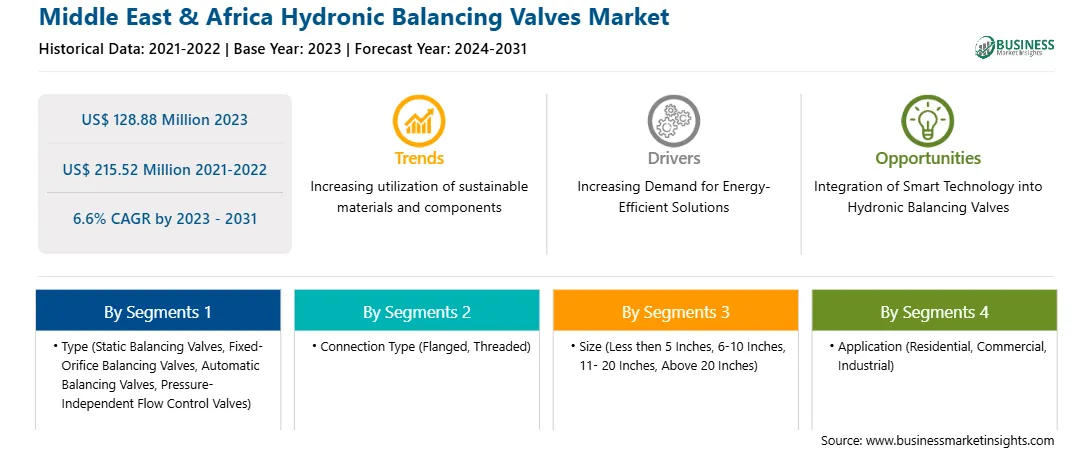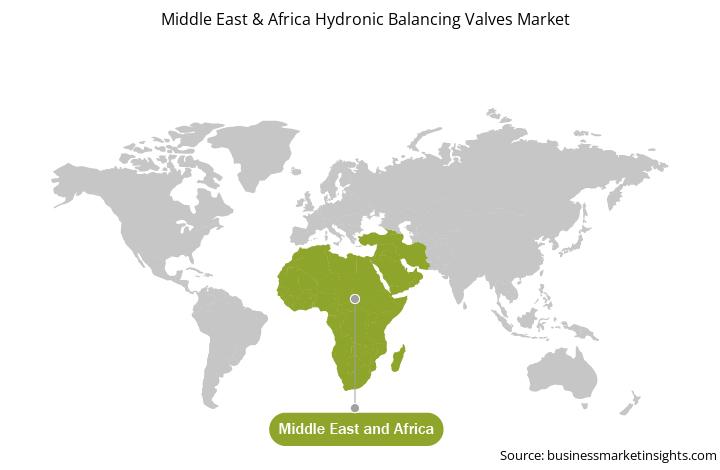Middle East & Africa Hydronic Balancing Valves Market
No. of Pages: 86 | Report Code: BMIRE00031077 | Category: Manufacturing and Construction
No. of Pages: 86 | Report Code: BMIRE00031077 | Category: Manufacturing and Construction
The Middle East & Africa hydronic balancing valves market was valued at US$ 128.88 million in 2023 and is expected to reach US$ 215.52 million by 2031; it is estimated to register a CAGR of 6.6% from 2023 to 2031.
The increasing concern for environmental pollution and carbon emissions from different industries has encouraged the governments of several nations to adopt more eco-friendly and sustainable alternatives with low to zero carbon emission rates. The industrial sector is a major carbon-centric sector with a substantial share in growing environmental pollution worldwide. The use of environment-friendly components such as hydronic balancing valves manufactured from recycled products can reduce the carbon footprint across the globe. Furthermore, the adoption of lead-free components for fabricating hydronic balancing valves for use in commercial and public infrastructure is rising and is anticipated to become more prominent in the coming years. Companies like ACS Valves, and Valmet are focusing on developing valves from recycled products. Thus, the increasing proliferation and usage of sustainable components as a viable alternative to conventional hydronic balancing valves in the commercial and public infrastructure sector is anticipated to fuel the market growth in the coming years.
The Middle East & Africa (MEA) is steadily witnessing significant potential for the Middle East & Africa hydronic balancing valves market growth. The regulations stated by governments of various countries in the Middle East are focused on energy efficiency and emphasize the usage of eco-friendly refrigerants, which are the least detrimental to the environment. This boosts the need for HVAC systems as these systems in countries such as South Africa, Saudi Arabia, and the UAE. The growing utilization of HVAC systems boosts the demand for hydronic balancing valves in the Middle East & Africa. Extreme weather conditions, growth in infrastructure and urban development projects, and increasing population are other factors boosting the utilization of HVAC systems, which is also propelling the Middle East & Africa hydronic balancing valves market across various countries in the Middle East & Africa. The rising focus on developing construction projects such as modern utilities and infrastructure facilities of smart cities and an increasing number of global events are encouraging global players to invest in the Middle East & Africa hydronic balancing valves market in the Middle East & Africa. For example, events such as the FIFA World Cup 2022, Dubai Expo 2020, and Dubai 2022 Winter Olympics have led large-scale companies and government agencies to build new-age shopping centers, hospitals, hotels, airports, and apartments, among others. Thus, the rise in infrastructure development fuels the Middle East & Africa hydronic balancing valves market growth.

Strategic insights for the Middle East & Africa Hydronic Balancing Valves provides data-driven analysis of the industry landscape, including current trends, key players, and regional nuances. These insights offer actionable recommendations, enabling readers to differentiate themselves from competitors by identifying untapped segments or developing unique value propositions. Leveraging data analytics, these insights help industry players anticipate the market shifts, whether investors, manufacturers, or other stakeholders. A future-oriented perspective is essential, helping stakeholders anticipate market shifts and position themselves for long-term success in this dynamic region. Ultimately, effective strategic insights empower readers to make informed decisions that drive profitability and achieve their business objectives within the market.

| Report Attribute | Details |
|---|---|
| Market size in 2023 | US$ 128.88 Million |
| Market Size by 2031 | US$ 215.52 Million |
| Global CAGR (2023 - 2031) | 6.6% |
| Historical Data | 2021-2022 |
| Forecast period | 2024-2031 |
| Segments Covered |
By Type
|
| Regions and Countries Covered | Middle East and Africa
|
| Market leaders and key company profiles |
The geographic scope of the Middle East & Africa Hydronic Balancing Valves refers to the specific areas in which a business operates and competes. Understanding local distinctions, such as diverse consumer preferences (e.g., demand for specific plug types or battery backup durations), varying economic conditions, and regulatory environments, is crucial for tailoring strategies to specific markets. Businesses can expand their reach by identifying underserved areas or adapting their offerings to meet local demands. A clear market focus allows for more effective resource allocation, targeted marketing campaigns, and better positioning against local competitors, ultimately driving growth in those targeted areas.

The Middle East & Africa hydronic balancing valves market is categorized into type, connection type, size, application, and country.
Based on type, the Middle East & Africa hydronic balancing valves market is segmented into static balancing valves, fixed-orifice balancing valves, automatic balancing valves, and pressure-independent flow control valves. The static balancing valves segment held the largest market share in 2023.
In terms of connection type, the Middle East & Africa hydronic balancing valves market is segmented into flanged, threaded, and others. The flanged segment held the largest market share in 2023.
By size, the Middle East & Africa hydronic balancing valves market is segmented into less then 5 inches, 6-10 inches, 11- 20 inches, and above 20 inches. The less then 5 inches segment held the largest market share in 2023.
By application, the Middle East & Africa hydronic balancing valves market is segmented into residential, commercial, and industrial. The residential segment held the largest market share in 2023.
By country, the Middle East & Africa hydronic balancing valves market is segmented into South Africa, Saudi Arabia, the UAE, and the Rest of Middle East & Africa. Saudi Arabia dominated the Middle East & Africa hydronic balancing valves market share in 2023.
Danfoss AS, Johnson Controls International Plc, Xylem Inc., Victaulic Company, Oventrop GmbH & Co. KG, and Caleffi S.p.a. are some of the leading companies operating in the Middle East & Africa hydronic balancing valves market.
The Middle East & Africa Hydronic Balancing Valves Market is valued at US$ 128.88 Million in 2023, it is projected to reach US$ 215.52 Million by 2031.
As per our report Middle East & Africa Hydronic Balancing Valves Market, the market size is valued at US$ 128.88 Million in 2023, projecting it to reach US$ 215.52 Million by 2031. This translates to a CAGR of approximately 6.6% during the forecast period.
The Middle East & Africa Hydronic Balancing Valves Market report typically cover these key segments-
The historic period, base year, and forecast period can vary slightly depending on the specific market research report. However, for the Middle East & Africa Hydronic Balancing Valves Market report:
The Middle East & Africa Hydronic Balancing Valves Market is populated by several key players, each contributing to its growth and innovation. Some of the major players include:
The Middle East & Africa Hydronic Balancing Valves Market report is valuable for diverse stakeholders, including:
Essentially, anyone involved in or considering involvement in the Middle East & Africa Hydronic Balancing Valves Market value chain can benefit from the information contained in a comprehensive market report.